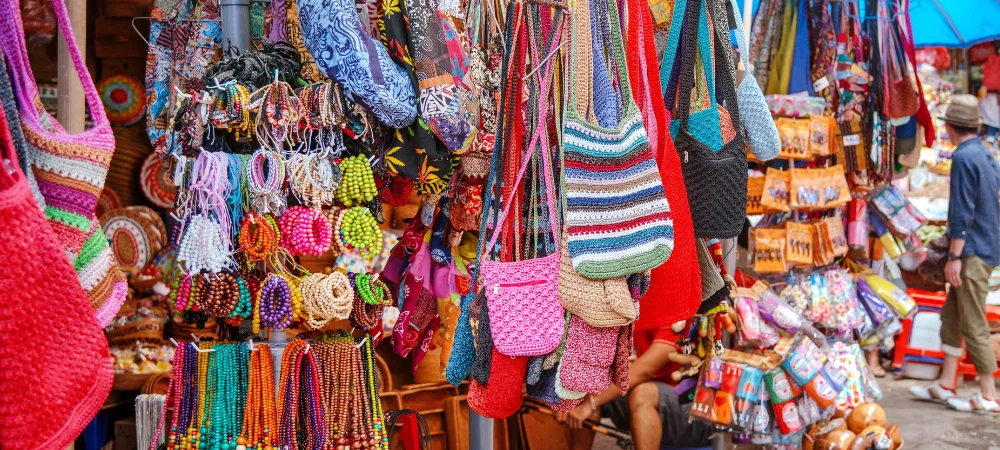Souvenirs with Soul: A Guide to Finding Authentic Balinese Keepsakes
When you visit the enchanting island of Bali, you don’t just take home memories and photographs – you bring back a piece of its soul. Bali’s rich cultural tapestry weaves through every market, workshop, and gallery, offering a myriad of souvenirs that are as unique and vibrant as the island itself.
But how do you sift through the commonplace to find a keepsake that truly captures the spirit of Bali? This guide will lead you to the most authentic Balinese souvenirs that are worth making room in your suitcase for, many of which you can pick up near your private Seminyak villa.
The Traditional Art of Balinese Batik
Batik is the heart of Indonesian textile art, especially poignant in Bali where it represents a tapestry of cultural narratives. This ancient dyeing technique uses wax to resist color on fabric, creating diverse patterns that are deeply rooted in the island’s heritage. Each design is steeped in symbolism, often representing nature, mythology, and the complexity of life.
In Bali, authentic batik is available in markets and villages where artisans have been perfecting their craft for generations. Ubud Market and Tohpati Village are renowned for their quality batik, where you can find a range of items from clothing to artistic wall hangings.
For those seeking an immersive experience, Balinese batik workshops offer a window into this cultural art form. Visitors can participate in the creation process, from waxing with a ‘canting’ to dyeing the cloth, resulting in a personal and unique souvenir.
Balinese Coffee – The Island’s Aromatic Souvenir
Balinese coffee is a testament to the island’s rich volcanic soil and time-honored cultivation practices. The journey from bean to brew is a treasured ritual that offers a unique taste profile distinct to this corner of the world. Kintamani, for instance, is known for its smooth coffee with citrus notes, a direct reflection of the region’s cooler climate and fertile grounds.
Seeking out authentic Balinese coffee leads to local plantations where traditions in coffee farming run deep. These plantations often welcome visitors, offering tours that culminate in the perfect opportunity to purchase beans at their freshest state. For a more urban experience, local markets and boutique coffee shops in Seminyak or Ubud showcase a selection of beans and grounds, often accompanied by insights from knowledgeable baristas.
For a tangible piece of Bali’s coffee culture, consider buying a traditional wooden coffee grinder or a ‘sock’ filter as a companion to the local beans. Not only does this equip you with the tools to recreate Balinese coffee at home, but it also supports the artisans who continue to uphold the island’s coffee legacy.
Taking home Balinese coffee means you’re bringing a piece of the island’s soul with you, one that will continue to brew in the warmth of your cup, invoking Bali’s lush landscapes with every sip.
The Spiritual Scent of Bali: Incense
In Bali, the delicate trails of smoke rising from incense are a common sight, infusing the air with fragrances that are as much a part of the island as its temples and beaches. Incense in Bali is deeply intertwined with the spiritual life of the island, playing a crucial role in daily offerings and ceremonies. The aromas range from the sweetly floral frangipani to the earthy sandalwood, each with its own purpose and symbolism.
Visitors can find these fragrant sticks in local markets, spiritual shops, and even at the temples. When selecting incense, you may encounter scents designed for relaxation, meditation, or health. Each scent carries a different meaning; jasmine is often used for love and prosperity, while lavender is believed to restore balance and create a peaceful atmosphere.
Purchasing incense in Bali not only allows you to bring the essence of the island’s tranquility home but also supports the local economy, especially the small-scale artisans who craft these aromatic treasures by hand. Moreover, the act of lighting incense back home can serve as a meditative reminder of your Balinese adventure, connecting you back to the island’s serene spirit.
In your search for the perfect incense, don’t hesitate to ask vendors about the significance of their scents and the stories behind them. In doing so, you’ll gain more than just a souvenir; you’ll learn the cultural narratives that each incense stick is imbued with, enhancing your appreciation of this age-old Balinese tradition.
Woven Wonders: The Intricacy of Balinese Textiles
The island of Bali is a tapestry of vibrant colors and patterns, captured perfectly in its traditional textiles. Endek and Songket are two of the island’s most exquisite fabric types, each woven with a complexity that tells a story of Balinese heritage and craftsmanship. Endek, known for its ikat patterns, is commonly worn for daily activities, while the shimmering threads of Songket denote a fabric used for special occasions.
Travelers to Bali are often mesmerized by these textiles, which are readily available in local markets and village boutiques. Authentic Balinese textiles are made using age-old weaving techniques passed down through generations. By purchasing these fabrics, visitors not only acquire a beautiful garment or home decor but also contribute to preserving this cultural art form.
To truly appreciate the value of these textiles, one can visit weaving centers or cooperatives where artisans display their skills. These visits allow for a deeper understanding of the fabric-making process and the significance of the motifs used in the designs, which often represent nature, mythology, and the cosmos.
Balinese Wood Carvings
Bali’s wood carving tradition is a form of storytelling, with skilled artisans chiselling away to reveal the island’s myths, deities, and natural splendour in pieces of local wood. From the intricate masks used in cultural dances to the elegant statues that grace temples and homes, each carving is a testament to the island’s spiritual and artistic heritage.
When visiting Bali, one is often struck by the detailed craftsmanship of the wood carvings found in art markets, galleries, and workshops. Mas Village, in particular, is famed for its woodcarving community, where the wood of choice ranges from the dense ebony to the fragrant sandalwood and the versatile suar wood.
Buying Balinese wood carvings is more than a transaction; it’s an act of supporting the local artisans and their age-old techniques. Each purchase helps to sustain the livelihood of these craftsmen and ensures the continuation of their art for future generations.
Savoring the Spice: Local Cooking Ingredients
The island’s culinary landscape is a paradise for food enthusiasts, spiced with an array of local ingredients that capture the island’s volcanic energy and tropical flair. The Balinese kitchen is renowned for its rich and diverse use of spices, such as galangal, lemongrass, and the fiery sambal that adds zest to every dish.
For visitors seeking to recreate the flavors of Bali at home, local markets are treasure troves of fresh spices, herbs, and blends. From the aromatic vanilla pods grown in the Balinese highlands to the prized Luwak coffee, these ingredients are the backbone of the island’s flavorful dishes.
Exploring a Balinese market offers an education in the local cuisine as vendors often share uses and recipes for their wares. Purchasing these cooking ingredients allows travelers to bring a taste of Bali back to their own kitchens, with each spice serving as a culinary memento of their travels.
Balinese Aromatherapy Oils
Bali’s natural abundance extends into the realm of wellness, with its wealth of aromatic oils that encapsulate the island’s essence. These oils, often referred to as the island’s liquid gold, are a distillation of Bali’s most fragrant flowers, plants, and herbs, used in spas and homes alike for their therapeutic properties.
Visitors are drawn to Balinese aromatherapy oils for their pure scents and the traditional methods used to extract them. Common ingredients like ylang-ylang, jasmine, and frangipani are not just pleasing to the senses but are also believed to have healing properties that promote relaxation and wellbeing.
The experience of selecting aromatherapy oils in Bali can be as soothing as their use. Many local wellness shops and markets in Ubud or along the streets of Canggu offer these oils, providing insights into their benefits and uses. Some places offer the opportunity to see the oil extraction process or even blend your own signature scent.
Balinese Jewellery
Balinese jewellery is a wearable art form, showcasing the island’s masterful craftsmanship in every curve and carve. The intricate designs, often inspired by nature and Hindu mythology, are brought to life in silver and gold by local artisans who have inherited their skills through generations.
Ubud and Celuk are two areas known for their silverwork, where you can witness the detailed process of jewelry making, from sketching designs to the final polish. The motifs often feature Balinese symbols like the ‘Om’, lotus flowers, or scenes from the Ramayana, allowing wearers to carry a piece of Balinese spirituality and tradition with them.
Purchasing jewelry in Bali not only offers a unique addition to your collection but also supports the local craftsmen and their communities. Each piece tells the story of Bali’s rich culture, whether it’s a delicate filigree bracelet, a statement necklace, or a pair of finely etched earrings.
Handwoven Baskets
The craft of handwoven baskets in Bali is a blend of functionality and art, with each twist and coil of palm leaf or bamboo signifying the island’s connection to nature and the daily life of its people. These baskets come in various shapes and sizes, designed for a multitude of uses – from daily offerings to the gods, storage of rice, or even as stylish bags for a day out.
Balinese basketry is distinguished by its sturdiness and intricate patterns, often created by artisan communities in villages like Tenganan and Sidemen. Here, the tradition of weaving is not just a livelihood but a cultural expression passed down through generations, with each basket telling a story of family heritage and communal bonds.
Tourists can find these eco-friendly baskets in local markets, where selecting the perfect one becomes an interactive experience. The weavers or vendors will often share the significance of the patterns, the best uses for each type of basket, and the stories of the hands that crafted them.
Melodic Memories: Gamelan Instruments
The resonant sound of the Gamelan is the heartbeat of Balinese culture, with its gongs, drums, and flutes creating an ensemble that is instantly evocative of the island’s vibrant life. Gamelan music, traditional to Bali and Java, is more than entertainment; it’s an art form that accompanies dances, rituals, and ceremonies, integral to the Balinese way of life.
If you wish to take home a piece of Bali’s musical soul, Gamelan instruments themselves can be profound souvenirs. Smaller instruments like the ‘gangsa’ (a type of metallophone) or bamboo angklung are portable and available for purchase at local markets or from craftsmen in villages known for their musical instrument craftsmanship.
However, it’s not just about acquiring an instrument; it’s about understanding its cultural value and the skill required to craft it. Visitors are encouraged to visit artisans who specialize in making these instruments, where they can witness the meticulous process of shaping, tuning, and often adorning them with intricate designs. These visits can be enlightening experiences, rich with the sounds and stories of the Gamelan tradition.
Making Your Choice
Each Balinese souvenir carries a story, a tradition, and a little bit of the island’s magic. When you choose a keepsake, you’re not just picking up a trinket; you’re preserving a slice of Bali’s soul. By opting for authentic, locally-made souvenirs, you’re not only bringing home a more meaningful memento but also supporting the artisans and keeping the island’s artistic legacy alive. So, wander the markets, chat with the locals, and let your heart (and perhaps your senses) guide you to a treasure that will keep Bali close, long after your travels are over.
- Welcome Back To My Villas in Bali - November 17, 2021





